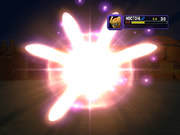Snag Ball
A Snag Ball (Japanese: スナッチボール Snatch Ball) is a type of modified Poké Ball seen in both Pokémon Colosseum and Pokémon XD: Gale of Darkness. Any type of Poké Ball available in the games can be turned into a Snag Ball by using a Snag Machine, and it is the only type of Poké Ball which can Snag an already caught Pokémon in the games.

A Snag Ball will have the same catch rate modifier as the Poké Ball that was used to create it, and is only visually different from the original Poké Ball by five streaks of white which appear around it and close on the Pokémon being snagged as the Ball does. This effect looks like a hand grabbing the Pokémon. When a Pokémon has been caught with a Snag Ball, the Pokémon's profile will show that it is contained in the type of Poké Ball that was initially converted into a Snag Ball.
Snag Balls were initially developed by Cipher so that Team Snagem could steal Pokémon from their Trainers and give them to Cipher, who would then change them into Shadow Pokémon. However, in both Pokémon Colosseum and Pokémon XD: Gale of Darkness, they are used by the main characters for the opposite purpose: to steal back the Shadow Pokémon from Cipher and purify them into normal Pokémon. In Pokémon Colosseum, every Poké Ball used will be converted into a Snag Ball, since there are no wild Pokémon to be found in Orre. In Pokémon XD: Gale of Darkness, Poké Spots are introduced, and normal Poké Balls can be used to catch wild Pokémon without being converted into Snag Balls, but snagging Shadow Pokémon is still the primary method of catching Pokémon.
Trivia
- The Mewtwo Balls used by Mewtwo in the first movie resemble Snag Balls in that they can capture a Pokémon that already has a Trainer, although Mewtwo Balls could catch regular Poké Balls too, hinting at the Mewtwo Balls simply being storage devices.
In other languages
| ||||||||||||||||||
| This item article is part of Project ItemDex, a Bulbapedia project that aims to write comprehensive articles on all items. |
